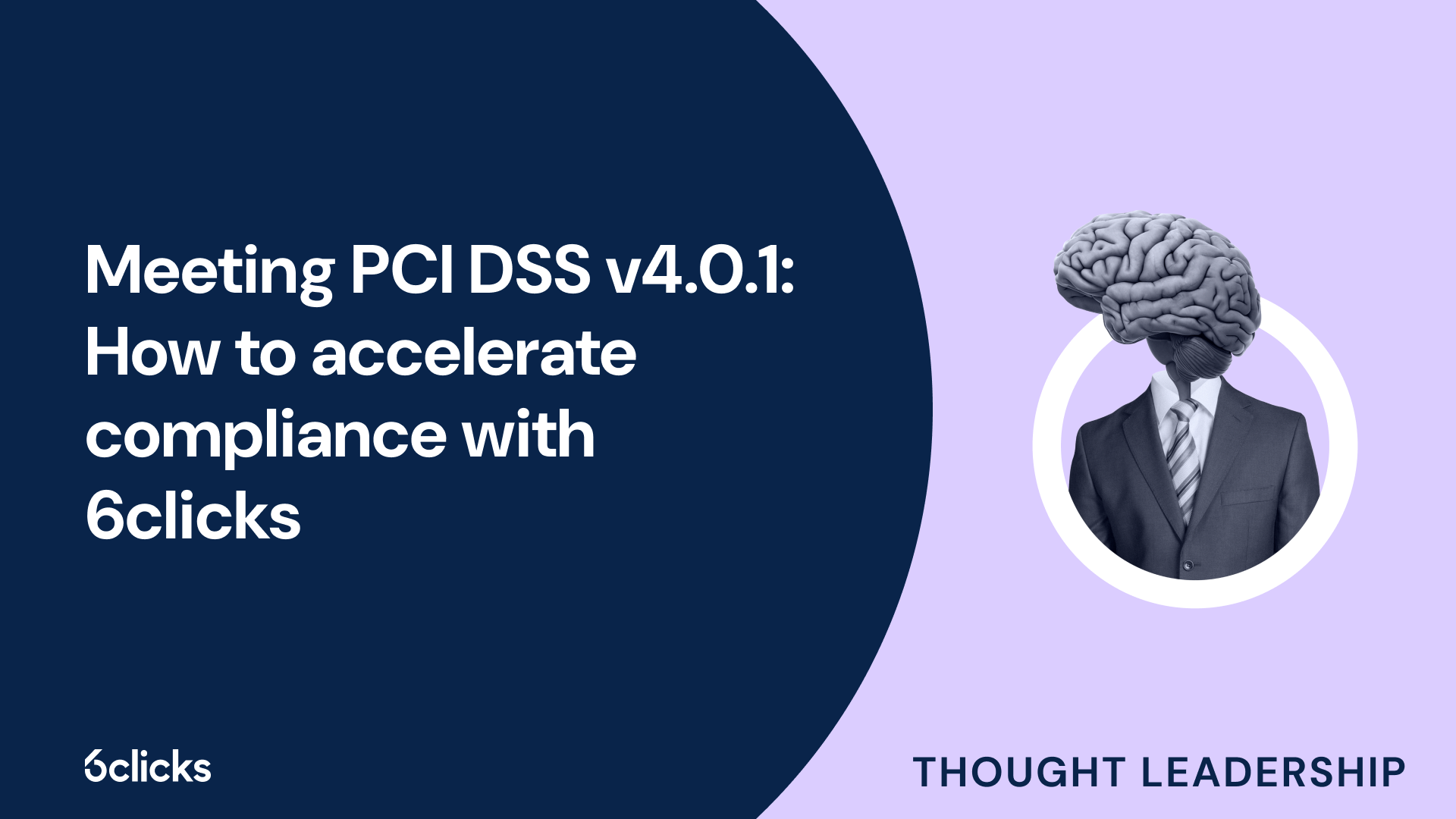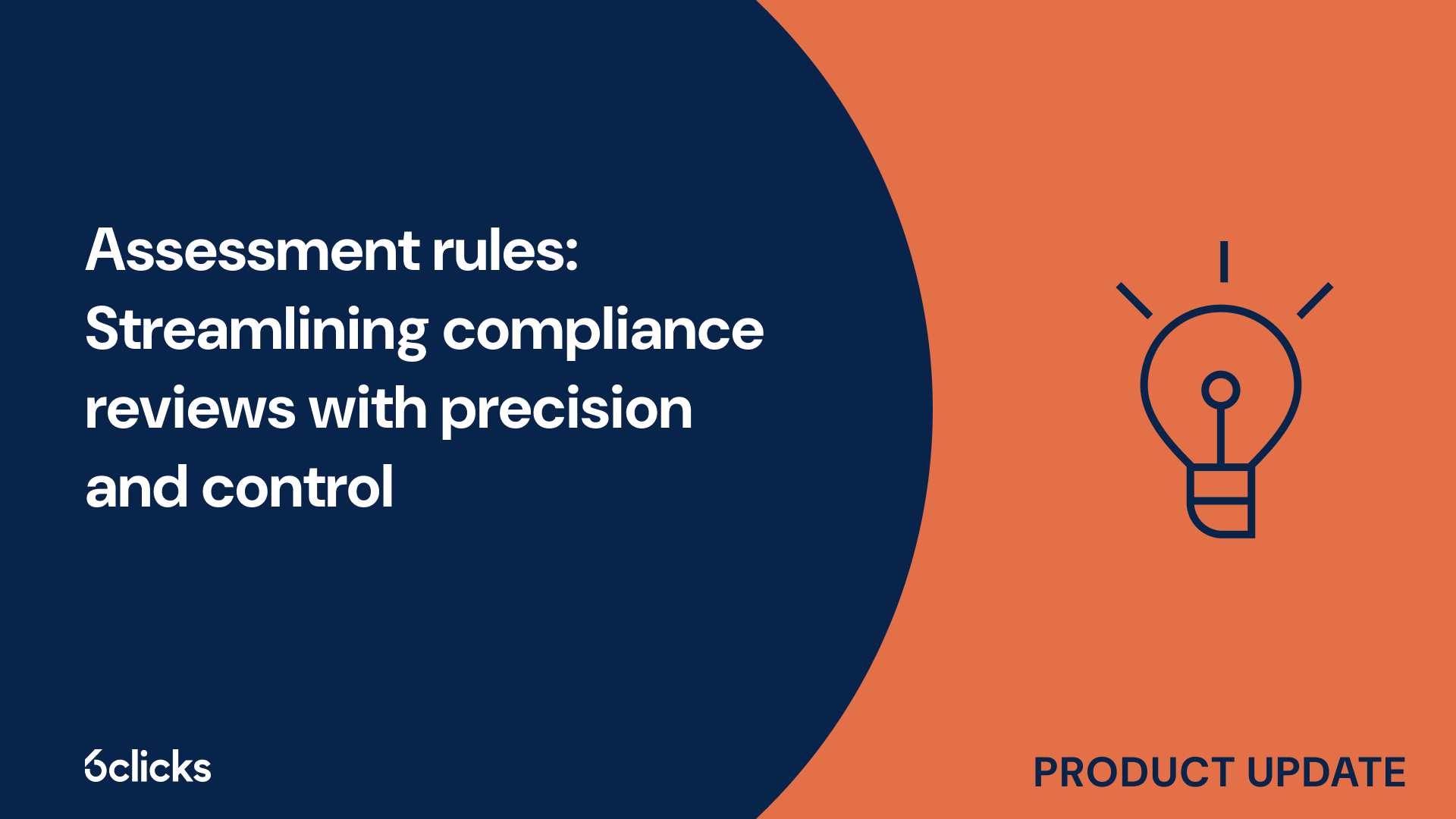The GRC buyer’s guide for 2025: Building resilience with AI-powered, federated solutions
Discover the ultimate GRC buyer's guide for 2025! Uncover how AI-powered, federated solutions transform compliance and security management for industries like government, aerospace, banking, and more. Learn about centralized control, continuous compliance, and advanced cyber GRC capabilities. Download now!
-1.png?width=200&height=249&name=Group%20193%20(1)-1.png)
The GRC buyer’s guide for 2025: Building resilience with AI-powered, federated solutions
What is enterprise risk?
Enterprise risk refers to the potential risks and uncertainties that an organization faces in achieving its objectives. These risks can come in various forms and can impact different aspects of the organization, including its operations, strategies, finances, compliance, and reputation. By understanding and managing these risks effectively, organizations can mitigate the negative consequences and seize opportunities for growth. Enterprise risk management is an essential component of an organization's overall risk management framework, helping to identify, assess, and respond to potential risks. It involves a systematic approach that involves the entire organization, from the board of directors to the executive management team, to ensure that risk management processes are integrated into day-to-day operations and business units. By proactively managing enterprise risks, organizations can enhance their resilience, protect their assets, and achieve their business goals.
Types of enterprise risk
Enterprise risk refers to the potential risks and uncertainties that can affect the entire organization's ability to achieve its business goals. There are three main types of enterprise risk: operational risk, strategic risks, and financial risks.
1. Operational Risk:
Operational risk is the risk associated with the day-to-day operations and internal processes of the organization. It includes risks related to systems and processes, human error, technology failures, and regulatory compliance. Causes of operational risk may include inefficient processes, employee misconduct, or external events. Examples of operational risk include supply chain disruptions, cybersecurity breaches, and legal compliance violations. Mitigating strategies for operational risk include implementing robust risk management processes, regular employee training, and comprehensive internal controls.
2. Strategic Risks:
Strategic risks arise from the decisions and actions taken in pursuit of business strategies. This includes risks associated with entering new markets, launching new products, or making strategic investments. Strategic risks are driven by factors such as market competition, changing customer preferences, or external economic conditions. Examples of strategic risks include failure to adapt to market changes, reliance on a single key customer, or inadequate diversification. Mitigating strategies for strategic risks include conducting thorough market research, scenario planning, and regularly reviewing and adjusting business strategies.
3. Financial Risks:
Financial risks are related to the organization's financial position, cash flow, and ability to meet financial obligations. This includes risks such as credit risk, liquidity risk, and foreign exchange risk. Financial risks can be caused by factors such as economic downturns, changes in interest rates, or cash flow mismanagement. Examples of financial risks include defaulting on loans, loss of key customers leading to cash flow problems, or unexpected changes in exchange rates. Mitigating strategies for financial risks include maintaining a diversified customer base, implementing effective cash flow management practices, and hedging against foreign exchange risks.
Managing and mitigating these types of risks requires a comprehensive enterprise risk management framework. This involves identifying and assessing risks, establishing risk tolerance, developing risk response strategies, and monitoring key risk indicators. By proactively addressing these risks, organizations can protect their reputation, maintain operational efficiency, and achieve long-term success.
Type 1: operational risk
Operational risk is a crucial aspect of enterprise risk management as it encompasses the day-to-day operations and internal processes of an organization. This type of risk includes various potential threats such as system failures, human errors, technology disruptions, and regulatory compliance issues. Operational risks can arise from inefficient processes, employee misconduct, or external events beyond the control of the organization. Examples of operational risks include supply chain disruptions, cybersecurity breaches, or legal compliance violations, all of which can significantly impact the organization's ability to achieve its business goals. To mitigate operational risks, organizations must focus on implementing robust risk management processes, regular employee training, and comprehensive internal controls. By doing so, they can effectively identify, assess, and respond to operational risks to ensure smooth day-to-day operations and minimize potential disruptions.
Causes of operational risk
Operational risk in an enterprise can arise from various causes, both internally and externally. Internally, operational risk is often attributed to weaknesses or failures in internal processes, people, and systems. Inadequate internal processes can lead to inefficiencies, errors, and failures in the day-to-day operations of the organization. This can include insufficient controls, poor documentation, or outdated procedures.
Similarly, the people factor plays a significant role in operational risk. Incompetent or inadequately trained employees may make mistakes or engage in fraudulent activities, leading to financial losses and reputational damage. Additionally, the turnover of key personnel without sufficient knowledge transfer can disrupt critical operations and increase the likelihood of errors.
Operational risk can also be triggered by factors beyond the control of the organization, known as external events. These events can include natural disasters, political unrest, economic crises, or changes in regulations. Such events can disrupt supply chains, interrupt business operations, and create unforeseen financial and legal risks.
Examples of operational risk include global crises that impact market conditions, IT system failures that result in system downtime and data loss, data breaches that compromise sensitive information, fraud committed by employees or external actors, loss of key personnel without succession plans, and litigation due to non-compliance with regulatory requirements.
To mitigate operational risk, organizations need to identify their critical functions or processes that are essential for business continuity and implement risk management plans. This entails establishing robust internal controls, training employees effectively, updating systems and technologies, and monitoring external events that could potentially impact operations. By proactively managing operational risks, businesses can enhance their resilience and protect their reputation, financial stability, and overall success.
Examples of operational risk
Operational risk refers to the potential for losses resulting from inadequate or failed internal processes, people, and systems or from external events. It can have a significant impact on the day-to-day operations and profitability of a company.
In various business scenarios, operational risks can arise from employee errors, asset damage, and external fraud. For example, a manufacturing company may face operational risk when employees make mistakes in the production process, leading to defective products or costly rework. This can result in increased expenses and lost sales opportunities, impacting profitability.
Operational risk can also arise from asset damage. For instance, a retail store may face the risk of theft, product damage, or equipment failure. These incidents can disrupt normal operations, result in inventory shrinkage, and necessitate the need for repairs or replacements, leading to financial losses and potential reputational damage.
External fraud is another example of operational risk. A company may be targeted by cybercriminals who gain unauthorized access to its systems, compromising customer data or conducting fraudulent transactions. This can result in financial loss, damage to the company's reputation, and legal consequences.
Mitigating operational risk
Mitigating operational risk is crucial for organizations to protect their reputation, financial stability, and overall business operations. By implementing effective strategies and measures, companies can minimize the likelihood and impact of operational risk incidents.
One strategy is to establish strong internal controls and procedures. This involves clearly defining roles and responsibilities, implementing checks and balances, and regularly monitoring and reviewing processes. By doing so, organizations can reduce the chances of employee errors and identify potential issues before they escalate.
Another measure is to invest in employee training and development. By providing comprehensive training programs and ongoing education, companies can improve the skills and knowledge of their workforce, reducing the likelihood of mistakes that can lead to operational risks.
Regular risk assessment and monitoring are also essential. Organizations should identify and evaluate their critical functions, processes, and systems to understand the potential risks they face. This information can then be used to develop effective risk management plans, prioritize mitigation efforts, and allocate resources accordingly.
Additionally, implementing technology solutions such as enterprise risk management software can help streamline risk identification, assessment, and response processes. These tools provide real-time visibility into operational risks, enable proactive risk monitoring, and facilitate efficient decision-making.
Type 2: strategic risks
Strategic risks refer to potential threats and uncertainties that can hinder an organization's ability to achieve its business goals and objectives. These risks are related to the overall strategy and direction of the company and can arise from changes in the market, industry trends, technological advancements, competitive landscape, and regulatory environment. Strategic risks can have a significant impact on the long-term success and sustainability of an organization, making it crucial for businesses to proactively identify, assess, and manage these risks. By having a clear understanding of their strategic risks, companies can make informed decisions, adjust their business strategies, and seize opportunities to gain a competitive advantage in the marketplace. This requires continuous monitoring of the external environment, close collaboration with key stakeholders, proactive planning, and a willingness to adapt to changing circumstances. Effective strategic risk management is an essential component of an enterprise risk management framework and helps organizations navigate uncertainties while pursuing their strategic objectives.
Causes of strategic risks
Strategic risks are those risks that can impact an organization's strategic direction and long-term success. These risks originate from various causes and it is essential to understand them in order to effectively manage and mitigate them. Here are some common causes of strategic risks:
- Changing consumer demand: Consumer preferences and demands can shift over time, impacting an organization's ability to meet customer needs effectively. Failure to adapt to changing consumer demands can lead to a loss of market share and competitive advantage.
- Rivalry: Intense competition within an industry can pose a significant strategic risk. Competitors may introduce new products or services, adopt more efficient business models, or offer lower prices, which can erode an organization's market position.
- Reputation loss: A tarnished reputation can have long-lasting negative effects on an organization's strategic direction. Negative publicity, customer dissatisfaction, product recalls, or ethical lapses can damage a company's image and undermine consumer trust and loyalty.
- Entry of new competition: The entry of new competitors in the market can disrupt an organization's strategic plans. New market entrants may bring innovative products, disruptive technologies, or lower-cost offerings, posing a threat to established businesses.
- Social trends: Changing social, cultural, or demographic trends can create strategic risks for organizations. Failure to adapt to evolving societal values or preferences can result in a loss of market relevance and competitive advantage.
Examples of strategic risks
Examples of strategic risks can have a significant impact on the future plans of a company. One such risk is the loss of strategy to a competitor. This can occur when a competitor develops a more innovative or disruptive product, which can quickly capture market share and render the company's existing strategy ineffective. For instance, if a technology company fails to anticipate and adapt to the rapid advancements in artificial intelligence, it may lose its market leadership to a competitor that offers superior AI-driven solutions.
Another example of a strategic risk is pricing undercutting by competitors. This occurs when competitors offer similar products or services at lower prices, thereby eroding the market share and profitability of the company. For example, if an apparel retailer sets its prices at a premium but fails to differentiate its products enough to justify the higher price, competitors offering similar quality products at lower prices can attract customers away, causing a decline in sales and market position.
Additionally, market disruption by competitors is another strategic risk. This can occur when new entrants or existing competitors bring disruptive technologies or business models into the market, fundamentally altering the industry landscape. For instance, the rise of ride-sharing companies disrupted the traditional taxi industry by providing a more convenient and cost-effective alternative, leading to a decline in market share and revenues for traditional taxi companies.
Mitigating strategies for strategic risks
- Diversification: A key strategy to mitigate strategic risks is to diversify the organization's product or service offerings. By expanding into new markets or introducing new innovative products, the organization can reduce its dependence on a single product or market segment. This helps to minimize the impact of potential threats or disruptions to the organization's strategic goals. Diversification also allows the organization to capitalize on emerging opportunities and stay ahead of competitors.
- Continuous Market Research: Conducting regular market research enables organizations to gather valuable insights into customer preferences, market trends, and competitors' strategies. This information can help identify potential threats or disruptions in the industry and allow the organization to proactively adjust its strategic goals and business strategies accordingly. By staying informed and adapting to changing market conditions, the organization can effectively mitigate strategic risks.
- Strategic Partnerships and Alliances: Collaborating with strategic partners can provide numerous benefits for organizations. By forming partnerships or alliances with complementary businesses or industry leaders, organizations can leverage their combined expertise, resources, and networks to mitigate strategic risks. Such partnerships can help create synergies, increase market penetration, enhance innovation, and reduce costs, ultimately ensuring future success and minimizing the impact of potential threats or disruptions.
These mitigating strategies for strategic risks focus on the proactive management of potential threats or disruptions to the organization's strategic goals. By implementing these strategies, organizations can strengthen their resilience, enhance their competitive advantage, and ensure sustainable success in a dynamic and unpredictable business environment.
Type 3: financial risks
Financial risks are a significant concern for organizations as they can have a direct impact on the financial stability and viability of the company. These risks encompass a wide range of potential events that could adversely affect the organization's financial performance, including market fluctuations, credit defaults, liquidity issues, and currency exchange rate changes. It is essential for organizations to effectively manage and mitigate these risks to safeguard their financial health and ensure long-term success. In this article, we will explore three types of financial risks that organizations need to consider and address in their enterprise risk management framework.
Causes of financial risks
Financial risks can arise in an organization due to various factors. One significant cause of financial risks is interest rate fluctuations. Changes in interest rates can significantly impact the cost of borrowing and the return on investments, leading to potential losses or reduced profitability.
Another factor contributing to financial risks is cash flow volatility. If an organization experiences cash flow issues, it may struggle to meet its financial obligations, such as debt payments or supplier payments. This can lead to financial distress or even bankruptcy.
Inflation is another cause of financial risks. Rising inflation erodes the purchasing power of an organization's cash flows and assets. This can lead to increased operational costs and reduced profitability, affecting the financial stability of the organization.
Additionally, changes in asset values can contribute to financial risks. Fluctuations in the value of an organization's assets, such as investments or real estate, can impact its overall financial position. A decline in asset values can result in losses or reduced net worth, affecting the organization's ability to meet its financial obligations.
To effectively manage financial risks, organizations should regularly assess and monitor these factors. This includes conducting sensitivity analysis to evaluate the potential impact of interest rate changes, cash flow volatility, inflation, and asset value fluctuations. By identifying potential risks and developing appropriate risk management strategies, organizations can better navigate financial uncertainties and safeguard their financial stability.







